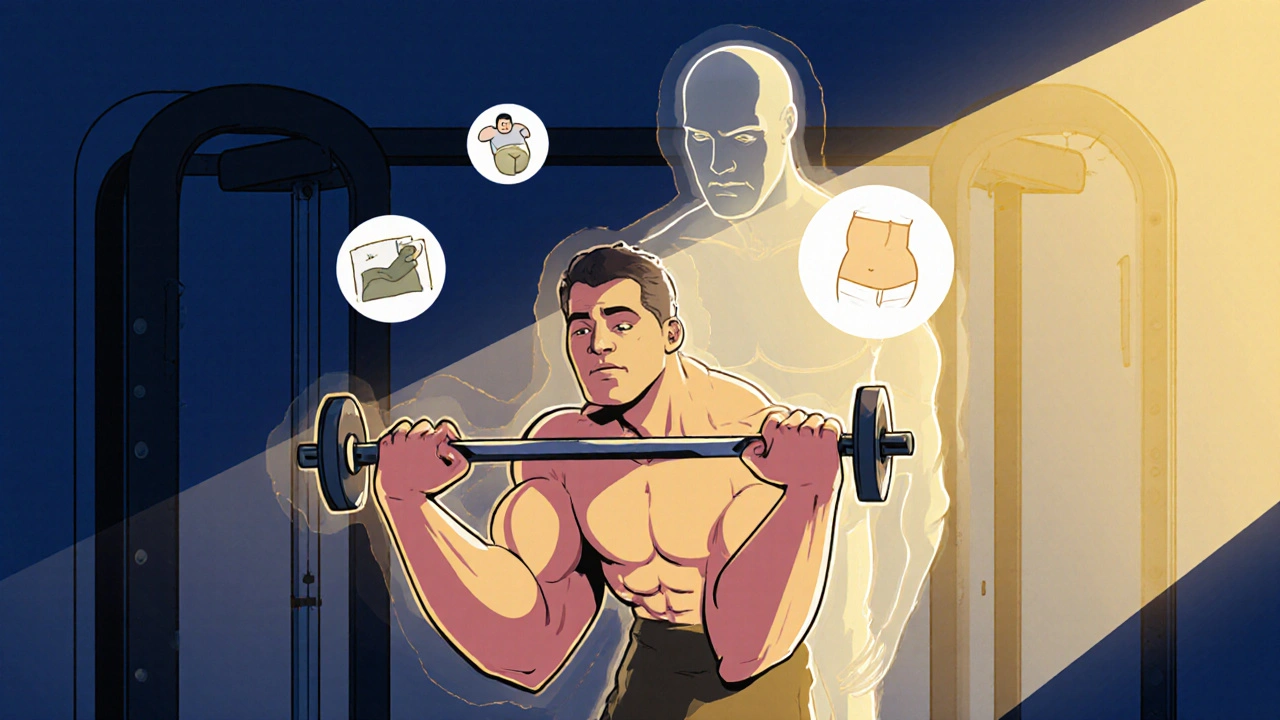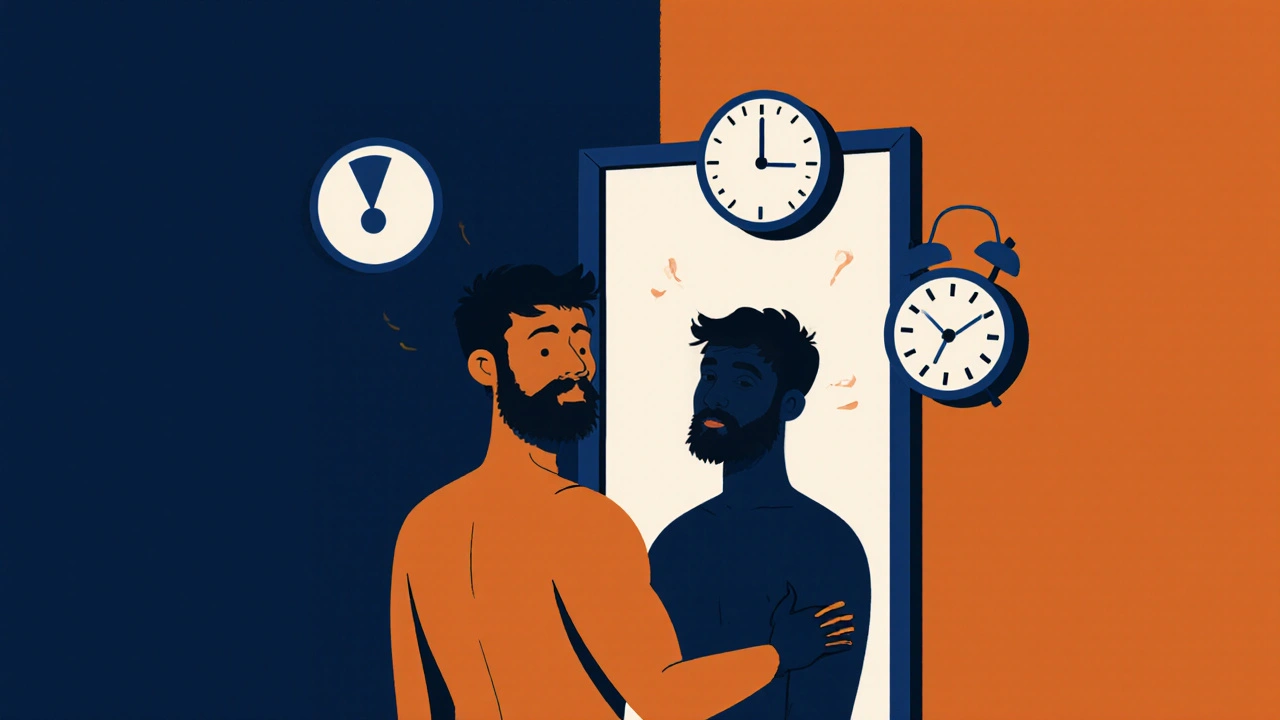What Is Male Hypogonadism?
Male hypogonadism is a condition where the testes don’t produce enough testosterone, the main male sex hormone. It’s not just about feeling tired-it’s a hormonal imbalance that affects muscle, mood, energy, and sexual health. About 4 to 5 million men in the U.S. have it, and the numbers rise with age: 20% of men between 60 and 70, and over half of men over 80, have testosterone levels below the clinical threshold.
There are two main types. Primary hypogonadism means the testes themselves aren’t working right. This could be from genetic issues like Klinefelter syndrome, past mumps infections, or too much iron in the blood (hemochromatosis). In this case, your body tries to fix it by pumping out more LH and FSH hormones-so those levels go up.
Secondary hypogonadism is more common, making up 85-90% of cases. Here, the problem isn’t the testes-it’s the brain. The hypothalamus or pituitary gland isn’t sending the right signals to tell the testes to make testosterone. This often happens because of obesity, chronic opioid use, or pituitary tumors. The hormone levels (LH and FSH) stay low or normal, even though testosterone is too.
What Are the Real Signs of Low Testosterone?
Low testosterone doesn’t always mean you’re losing your libido. Symptoms can be subtle, and many men blame stress, aging, or sleep deprivation. But if you’re experiencing three or more of these, it’s worth checking:
- Reduced or absent morning erections
- Decreased sex drive (reported in 85% of diagnosed men)
- Loss of muscle mass-up to 30% in long-term cases
- Increased body fat, especially around the belly
- Constant fatigue, even after good sleep
- Mood swings, irritability, or feelings of depression
- Reduced body hair or thinning facial hair
- Testicles smaller than 15 mL (measured with a simple tool called a Prader orchidometer)
Some men develop mild anemia because testosterone helps make red blood cells. Hemoglobin can drop below 13.5 g/dL. Bone density also declines at 2-3% per year without treatment, raising the risk of fractures. About one-third of men with untreated hypogonadism develop osteoporosis.
How Is It Diagnosed?
You can’t just take a home test and assume you have low T. Diagnosis requires two things: symptoms and lab confirmation.
The American Urological Association says testosterone below 300 ng/dL is low. But here’s the catch: levels fluctuate. Testosterone peaks between 8 a.m. and 11 a.m., so blood tests must be done in the morning. And not all tests are equal. Immunoassays-common in many clinics-can give false highs by 15-20%. The gold standard is mass spectrometry.
Doctors also check LH, FSH, prolactin, and hematocrit. If your testosterone is borderline (250-350 ng/dL), they may measure free testosterone. If it’s under 65 pg/mL, treatment is often recommended.
For men with obesity, doctors often suggest lifestyle changes first. Losing 10% of body weight can boost testosterone by 150-200 ng/dL in 70% of cases. If that doesn’t help, or if symptoms are severe, then testing and treatment proceed.
Testosterone Replacement Therapy: The Main Treatment
If you have confirmed low testosterone and real symptoms, testosterone replacement therapy (TRT) is the standard. It doesn’t cure the condition-it replaces what your body isn’t making.
There are five main delivery methods:
- Gels and creams: Applied daily to clean, dry skin (arms, shoulders, abdomen). Absorption is around 85%, but you must avoid skin-to-skin contact for 6 hours after application. About 1.5% of partners or kids accidentally absorb it, causing unwanted side effects.
- Injections: Testosterone cypionate or enanthate, injected every 2-4 weeks. Costs $30-50 per month. Levels spike and drop, causing mood swings or energy dips between shots.
- Buccal tablets: Stick to your gum twice a day. They release testosterone slowly. Less popular due to gum irritation and taste.
- Subcutaneous pellets: Tiny pellets inserted under the skin every 3-6 months. No daily hassle, stable levels. Costs $500-1,000 per insertion. Requires a minor procedure.
- Oral capsules (Jatenzo): FDA-approved in 2023. Taken with a high-fat meal. First oral option that works reliably. No skin transfer risk. Must be taken with food to reach 95% absorption.
Each method has trade-offs. Gels are easy but risky around kids. Injections are cheap but inconsistent. Pellets are steady but invasive. Oral capsules are new and promising but expensive.
Who Shouldn’t Get TRT?
Not everyone is a candidate. TRT is dangerous if you have:
- Prostate cancer (active or untreated)
- Untreated severe heart failure
- Hematocrit above 50% (too many red blood cells)
- Untreated sleep apnea
The FDA added a black box warning in 2015 after studies showed a 30% higher risk of heart attack in men over 65 during the first 90 days of TRT. But newer research, like the 2022 Testosterone Trials, shows no increased risk in healthy men with proper monitoring.
Dr. Ronald Swerdloff from Harbor-UCLA says: “TRT should be for men with clear symptoms and confirmed low levels-not as a quick fix for aging.” Meanwhile, Dr. Abraham Morgentaler from Harvard argues that the fear around TRT and heart disease is outdated, citing studies showing 30% lower death rates in properly treated men.
What Happens After You Start?
Results vary. Most men notice:
- Improved energy and mood within 2-4 weeks
- Stronger morning erections by week 4-6
- Increased libido after 6-8 weeks
- Noticeable muscle gain after 3-6 months-especially with weight training
But not everyone responds. About 30% of men report no symptom improvement even after testosterone levels normalize. That means something else might be going on-sleep apnea, depression, thyroid issues, or chronic stress.
Monitoring is critical. You’ll need:
- Hematocrit every 3-6 months (must stay under 50%)
- PSA test at baseline and again at 3-6 months
- Testosterone level check at 3 months, then every 6-12 months
- Symptom tracking using the Aging Males’ Symptoms (AMS) scale
Side effects happen. Acne affects 35% of users. Testicular shrinkage occurs in 25%-this is normal with TRT because the body stops making its own testosterone. Polycythemia (too many red blood cells) affects 15% and may require blood draws.

Can You Stop TRT?
Yes-but it’s not simple. If your low testosterone was caused by obesity, losing weight might bring levels back up. Studies show 65% of men who lose 10% of body weight can stop TRT within 18 months. But if it’s genetic (like Klinefelter syndrome) or due to pituitary damage, TRT is usually lifelong.
Stopping TRT suddenly can cause a crash: fatigue, low mood, and loss of muscle. Some men go back to their pre-treatment levels and feel worse than before.
Only about 42% of men stay on TRT beyond two years. Reasons? Cost ($300-500/month out-of-pocket), inconvenience, side effects, or fear of long-term risks.
What’s New in 2025?
The field is evolving fast. The TRAVERSE trial, tracking 5,000 men over five years, will deliver final results in 2025. It’s the largest study ever on TRT and heart health-finally answering long-standing safety questions.
Another breakthrough is SARMs (selective androgen receptor modulators). Drugs like enobosarm are in Phase III trials. They build muscle and improve bone density without suppressing natural testosterone. That means no testicular shrinkage, no need for lifelong replacement. Still experimental, but promising.
The Endocrine Society’s 2024 guidelines will shift from fixed testosterone numbers to personalized treatment. Instead of just “fix the number,” doctors will ask: “What symptoms are you struggling with? What’s your body type? What’s your goal?” One man wants more energy. Another wants to regain muscle. Another just wants his sex drive back. Treatment will be tailored.
Final Thoughts: Is TRT Right for You?
Low testosterone isn’t just a number on a lab report. It’s a real, measurable condition that affects how you feel, move, and live. But it’s not a magic fix. TRT works best when:
- You have clear symptoms
- Two morning blood tests confirm low levels
- You’ve tried lifestyle changes first (if overweight)
- You’re willing to monitor your health regularly
- You understand the risks and benefits
Don’t rush into treatment because you saw a YouTube ad. Don’t avoid it because you’re scared of needles. Talk to an endocrinologist or urologist who understands the full picture. The goal isn’t to be young again-it’s to feel like yourself again.



Gabe Solack
November 18, 2025 at 09:16I started TRT last year after my doc confirmed my levels were at 210 ng/dL. Morning energy? Night and day. No more 3 p.m. naps. Gels are a pain but worth it. Just don’t forget to wash your hands after applying. 😅
Shilpi Tiwari
November 18, 2025 at 19:38Fascinating breakdown. The distinction between primary and secondary hypogonadism is clinically nuanced-especially the LH/FSH feedback dynamics. I’m curious about the assay methodology disparities: immunoassays vs. LC-MS/MS. The latter has superior specificity, particularly in obese populations where SHBG alterations skew results. Would love to see a reference for the 15-20% false-positive rate in immunoassays.
Denny Sucipto
November 18, 2025 at 20:31Man, this hit home. I thought I was just getting old-tired all the time, no motivation, couldn’t lift like before. Got tested, turned out I was at 220. Lost 15 lbs, tried to fix it myself. Didn’t work. Started TRT. My wife said I ‘came back to life.’ Not a magic bullet, but damn if it didn’t help me feel like me again. Just don’t skip the blood work. 😌
Holly Powell
November 20, 2025 at 16:25The assertion that TRT has ‘no increased risk’ in healthy men is dangerously oversimplified. The 2022 Testosterone Trials excluded men with pre-existing cardiovascular risk factors. The real-world population? 78% have metabolic syndrome. This isn’t ‘optimization’-it’s pharmaceutical normalization of aging. The FDA’s black box warning exists for a reason.
Emanuel Jalba
November 21, 2025 at 23:51THIS IS WHY MEN ARE BEING DESTROYED. Big Pharma pushes this like it’s a vitamin. You think your ‘low T’ is real? Or are you just mad because your girlfriend left you? I’ve seen guys go from ‘I need TRT’ to ‘I’m addicted to needles’ in 6 months. Wake up! You don’t need testosterone-you need therapy. 💔
Heidi R
November 23, 2025 at 13:00You didn’t mention the estrogen conversion risk. Testosterone aromatizes. Without an AI, you’ll get gynecomastia, water retention, mood crashes. Most docs don’t test estradiol. That’s malpractice.
Brenda Kuter
November 25, 2025 at 07:55I know a guy who started TRT and then his wife found out he was cheating because he got too confident. Now they’re divorced. And his testicles shrunk so much he won’t go swimming. TRT doesn’t fix your life-it just makes you more dangerous to yourself and everyone around you. 🚨
Sarah Frey
November 26, 2025 at 23:13Thank you for this comprehensive and evidence-based overview. The emphasis on symptom correlation over arbitrary lab thresholds is clinically sound. I particularly appreciate the mention of the AMS scale and the importance of lifestyle intervention prior to pharmacotherapy. This is the standard of care that should be widely disseminated.
Katelyn Sykes
November 27, 2025 at 12:33If you’re overweight and tired stop blaming your hormones and start lifting weights and eating less sugar I did it lost 40 lbs and my T jumped 200 points no needles no gels just real life changes
Yash Nair
November 28, 2025 at 15:21USA always pushing pills for everything. In India we have natural way - ashwagandha, shilajit, sunlight, exercise. Why you all so weak? You need to be man not lab rat. TRT is for cowards. Real men suffer in silence and still lift heavy.